When discussing legendary investors, Bill Ruane is a name that often surfaces among the greats. As the founder of the Sequoia Fund, Ruane carved out a remarkable legacy in the world of finance. His investment prowess wasn’t just about numbers; it was about a philosophy that emphasized value, rigorous research, and patience. Ruane’s approach wasn’t flashy or headline-grabbing, but it was profoundly effective, yielding impressive returns for his investors over decades.
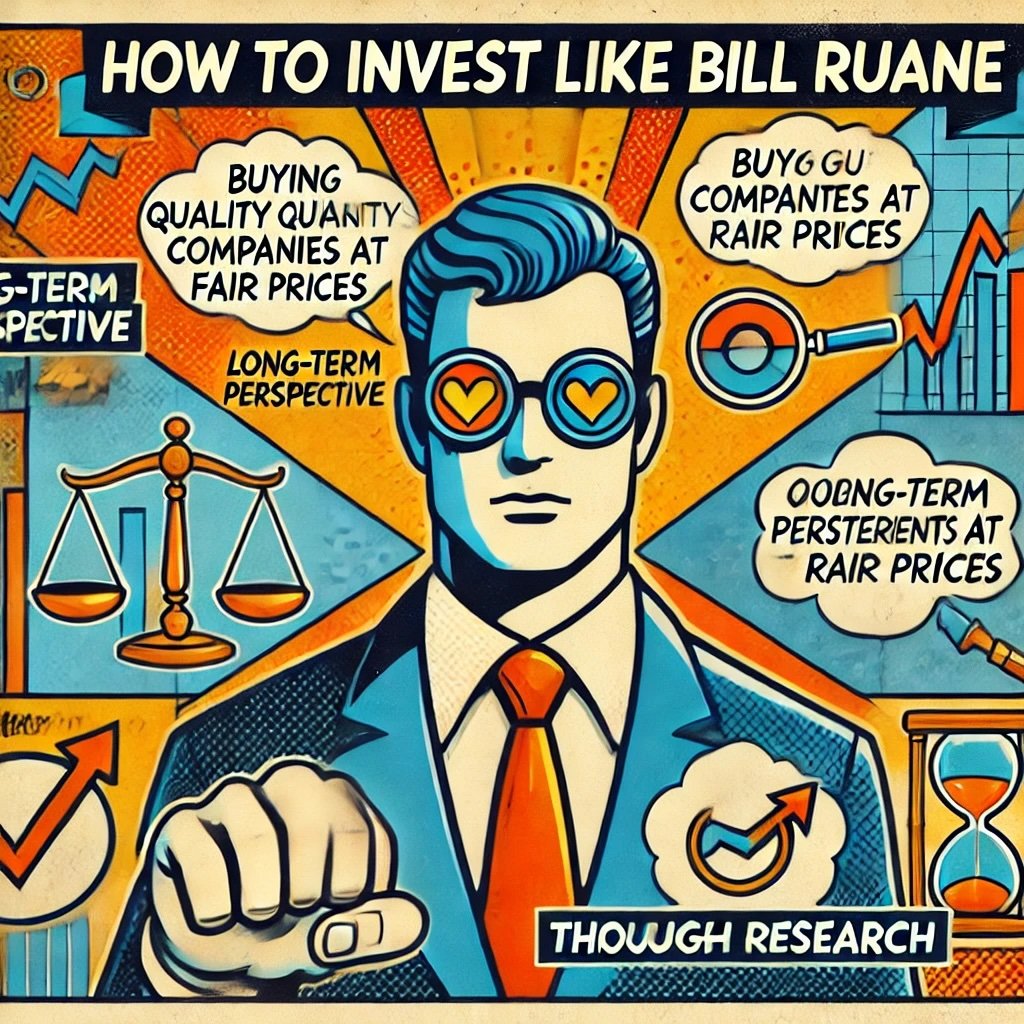
Born in 1925, Ruane’s journey into investing was significantly influenced by his time at Harvard Business School and his friendship with Warren Buffett. After meeting at a class taught by Benjamin Graham, the father of value investing, Ruane and Buffett formed a bond that would shape their investment careers. While Buffett went on to build Berkshire Hathaway, Ruane established the Sequoia Fund in 1970, bringing Graham’s principles to a broader audience.
Tip for Best Practices: Understanding the backgrounds of successful investors can provide valuable insights into effective investment strategies.
Meet Bill Ruane: The Man Behind the Sequoia Fund
So, why focus on Bill Ruane and the Sequoia Fund? The purpose here is to explore Ruane’s investment strategy and how he implemented it through the Sequoia Fund. We’ll delve into the fund’s commitment to value investing, the emphasis on meticulous research, and the long-term perspective that guided every investment decision. Whether you’re a seasoned investor or just starting out, there’s a wealth of knowledge to be gained from Ruane’s approach.
The Essence of the Sequoia Fund
The Sequoia Fund wasn’t just another mutual fund; it was a manifestation of Ruane’s investment philosophy. The fund focused on:
- Value Investing: Seeking undervalued companies with strong fundamentals.
- Rigorous Research: Conducting in-depth analysis before making investment decisions.
- Long-Term Perspective: Holding investments for extended periods to maximize returns through compounding.
Bold Move: The Sequoia Fund often deviated from market trends, staying true to its principles even when value investing was out of favor.
Value Investing at Its Core
Ruane was a staunch advocate of value investing, a strategy rooted in buying securities that appear underpriced by fundamental analysis. Influenced by Benjamin Graham’s teachings, Ruane looked for companies whose stock prices didn’t reflect their intrinsic value. This approach required patience, as it might take time for the market to recognize a company’s true worth.
He wasn’t swayed by market noise or short-term fluctuations. Instead, Ruane focused on the quality of the businesses, their management teams, and their long-term prospects. This disciplined approach allowed the Sequoia Fund to deliver consistent returns, outperforming many of its peers.
Tip for Best Practices: Consider adopting a value investing mindset by focusing on a company’s fundamentals rather than short-term market movements.

The Power of Rigorous Research
One of the hallmarks of Ruane’s strategy was his commitment to rigorous research. Before investing, he and his team would dive deep into a company’s financials, competitive position, and management quality. This thorough due diligence reduced risks and increased the likelihood of investing in companies that would perform well over time.
- In-Depth Analysis: Evaluating balance sheets, income statements, and cash flow statements.
- Competitive Positioning: Understanding the company’s market share and competitive advantages.
- Management Evaluation: Assessing the capabilities and integrity of the company’s leadership.
Bold Move: Ruane didn’t rely solely on public information; he often met directly with company management to gain deeper insights.
A Long-Term Perspective
Patience was more than a virtue for Ruane; it was a strategic asset. He believed in the power of compounding and understood that significant wealth is often built over time. By holding investments for the long term, the Sequoia Fund minimized transaction costs and capitalized on the sustained growth of high-quality companies.
Benefits of a Long-Term Approach:
- Reduced Costs: Fewer transactions mean lower fees and taxes.
- Less Stress: Avoiding the need to constantly monitor market fluctuations.
- Greater Returns: Allowing investments to grow and compound over years.
Tip for Best Practices: Embrace a long-term investment horizon to potentially enhance returns and reduce the impact of market volatility.
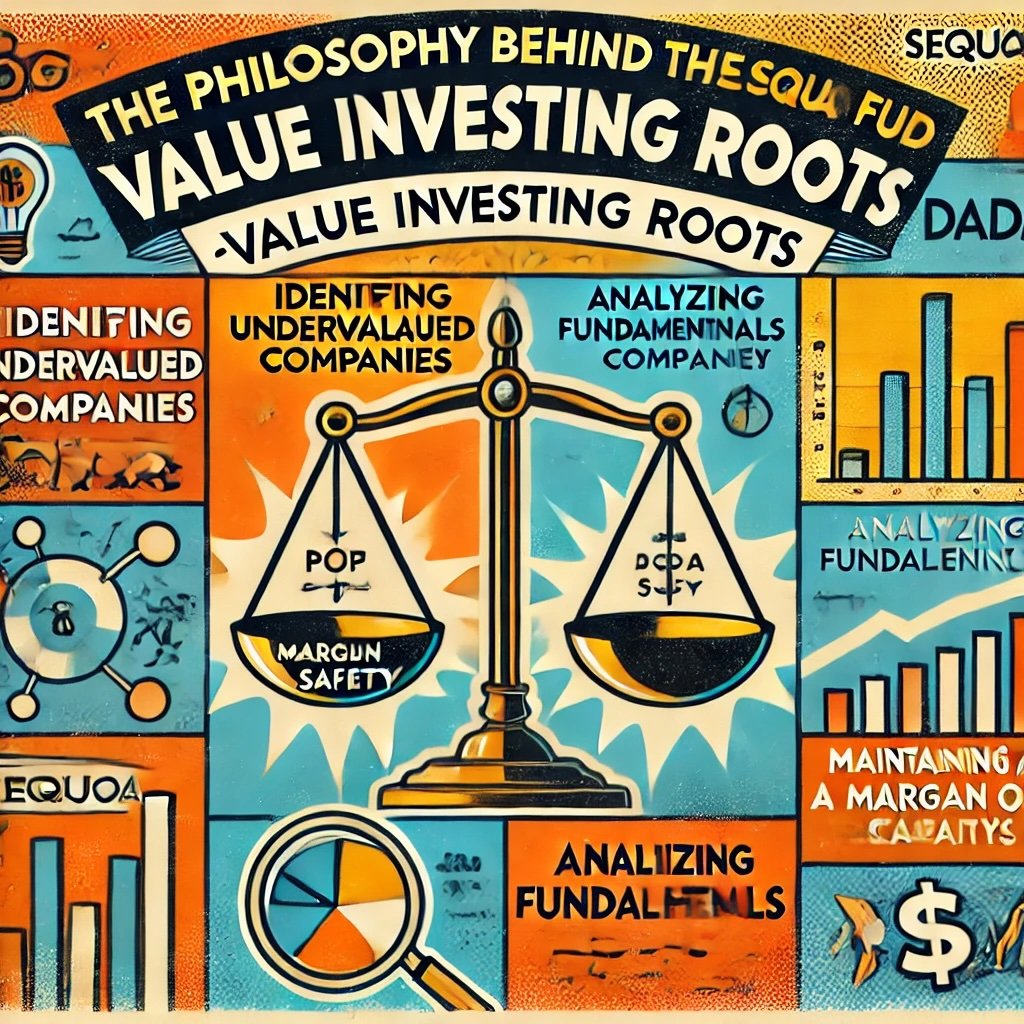
The Philosophy Behind the Sequoia Fund
Value Investing Roots: A Legacy of Wisdom
At the core of the Sequoia Fund lies a profound commitment to value investing, a philosophy deeply ingrained in Bill Ruane’s approach. Influenced by the teachings of Benjamin Graham, often referred to as the father of value investing, Ruane honed his investment strategy by focusing on companies undervalued by the market. His friendship and professional association with Warren Buffett further reinforced these principles, as both men shared a dedication to uncovering hidden gems in the stock market.
But what exactly is value investing? In essence, it’s the art of:
- Identifying Undervalued Companies: Finding businesses trading below their intrinsic value.
- Analyzing Fundamentals: Assessing financial health, earnings potential, and growth prospects.
- Maintaining a Margin of Safety: Investing with a buffer to protect against unforeseen market shifts.
Ruane didn’t chase trends or speculative ventures. Instead, he delved deep into financial statements and industry reports, seeking companies that the market had overlooked or misunderstood.
Tip for Best Practices: When evaluating a stock, focus on its intrinsic value rather than short-term market fluctuations. This long-term perspective can help you identify solid investment opportunities.
Focus on Quality: Investing in the Best
Ruane’s investment philosophy went beyond just finding undervalued stocks; he was equally committed to investing in high-quality companies with robust fundamentals. He believed that owning a piece of a great business was more valuable than any short-term gains from mediocre ones.
Characteristics of high-quality companies in Ruane’s eyes included:
- Strong Financial Performance: Consistent earnings growth and healthy balance sheets.
- Competitive Advantages: Unique products, brand loyalty, or patents that set them apart.
- Effective Management: Leadership with a proven track record of making smart decisions and acting ethically.
By zeroing in on such companies, Ruane aimed to build a portfolio that could withstand economic downturns and market volatility.
Bold Move: Prioritize quality over quantity. It’s better to invest in a handful of exceptional companies than to spread your resources thin across many average ones.

Long-Term Horizon: The Power of Patience
One of Ruane’s most significant beliefs was in the importance of a patient, long-term approach. He understood that wealth isn’t typically amassed overnight but rather grown steadily over time through disciplined investing.
Why adopt a long-term investment horizon?
- Compounding Returns: Earnings reinvested over time can lead to exponential growth.
- Reduced Transaction Costs: Fewer trades mean lower fees and taxes, which can erode profits.
- Emotional Discipline: Staying invested helps avoid impulsive decisions based on market hype or fear.
Ruane’s patience allowed him to hold onto quality investments, giving them time to reach their full potential. He wasn’t swayed by short-term market noise or temporary setbacks.
Tip for Best Practices: Before investing, ask yourself if you’re willing to commit to the long haul. Patience can be a significant ally in achieving superior returns.
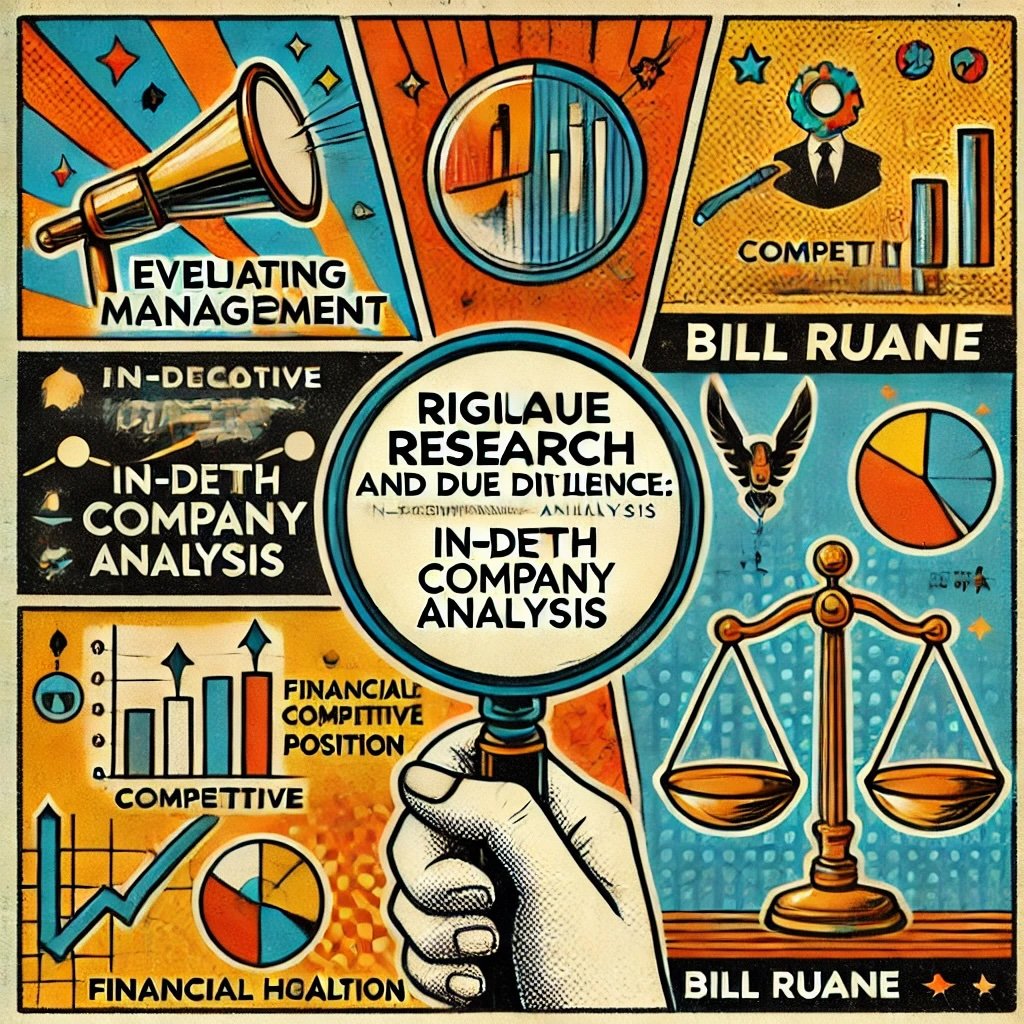
Rigorous Research and Due Diligence
In-Depth Company Analysis: Leaving No Stone Unturned
Bill Ruane wasn’t one to take shortcuts when it came to investing. His commitment to thorough research set him apart in the investment world. Before allocating funds to any company, Ruane and his team at the Sequoia Fund conducted exhaustive analyses. They delved deep into a company’s financial statements, scrutinizing every detail to understand its true financial health and growth potential.
Key aspects of Ruane’s company analysis included:
- Evaluating Management: Ruane believed that strong leadership was the cornerstone of a successful company. He assessed management’s track record, integrity, and vision for the future.
- Competitive Position: Understanding a company’s place in the market was crucial. Ruane analyzed industry dynamics, market share, and the company’s unique competitive advantages.
- Financial Health: He examined profitability, cash flow, debt levels, and other financial metrics to ensure the company was on solid footing.
He didn’t rely solely on numbers. Ruane understood that quantitative data could only tell part of the story. He sought to comprehend the qualitative aspects that could influence a company’s long-term success.
Tip for Best Practices: When researching a company, go beyond the surface. Dive into annual reports, listen to earnings calls, and read industry analyses to get a comprehensive view.
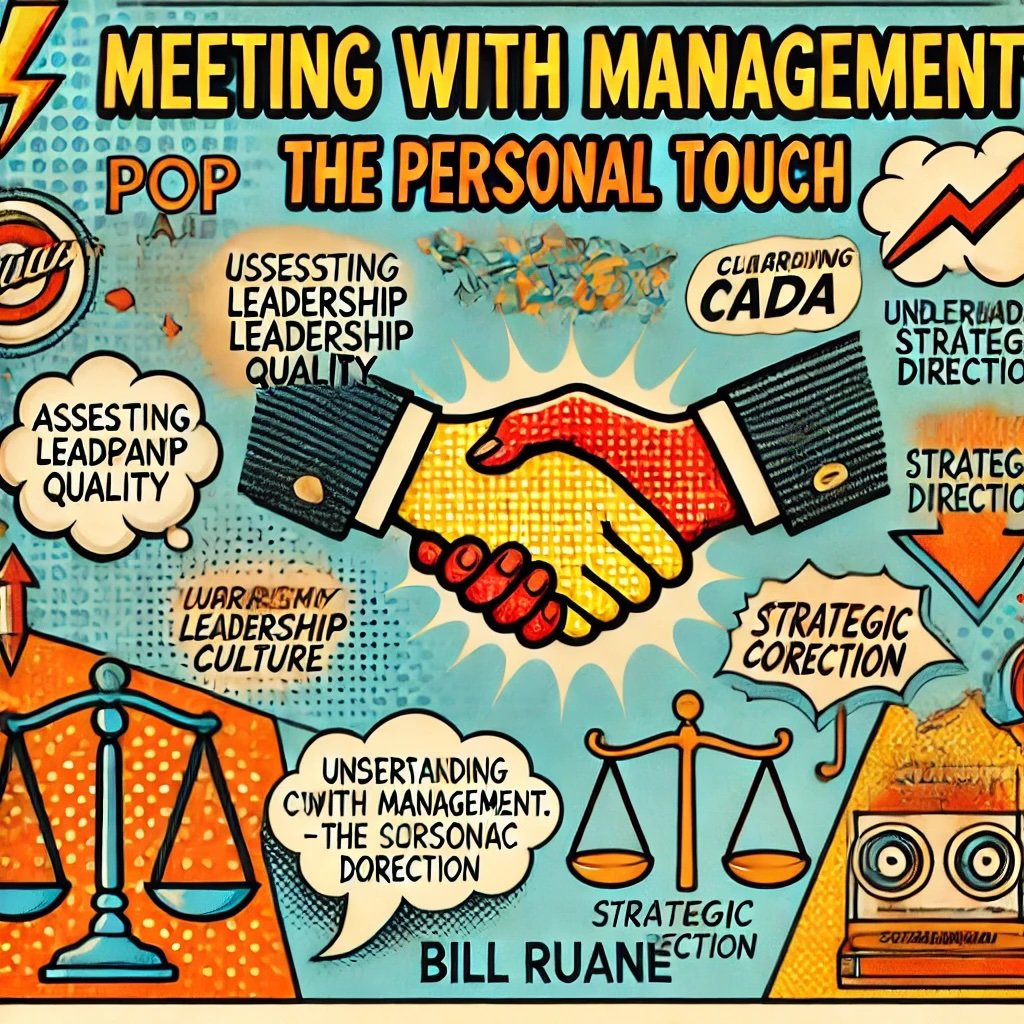
Meeting with Management: The Personal Touch
For Ruane, meeting directly with a company’s management was not just a formality—it was essential. These interactions provided invaluable insights that weren’t available in financial statements or market reports. By engaging with CEOs, CFOs, and other key executives, Ruane could assess their vision, competence, and integrity firsthand.
Benefits of meeting with management:
- Assessing Leadership Quality: Personal interactions help gauge the commitment and passion of the management team.
- Understanding Company Culture: Management discussions can reveal the company’s values and operational ethos.
- Clarifying Strategic Direction: Direct conversations allow for a deeper understanding of the company’s future plans and how they aim to achieve them.
Ruane’s emphasis on this personal touch underscored his belief that people drive businesses. A great company with poor leadership was a risk he wasn’t willing to take.
Tip for Best Practices: While individual investors may not have direct access to company executives, attending shareholder meetings, investor conferences, or listening to earnings calls can provide valuable insights into management’s perspectives.
Case Study: Investing in Berkshire Hathaway after Extensive Research
One notable example of Ruane’s rigorous research leading to a successful investment was his stake in Berkshire Hathaway. Ruane’s friendship with Warren Buffett provided him with unique insights, but it was his thorough analysis that convinced him to invest significantly in the company.
Key factors in Ruane’s decision:
- Management Evaluation: Warren Buffett’s reputation for prudent management and investment acumen was unparalleled. Ruane had immense respect for Buffett’s abilities and integrity.
- Competitive Advantage: Berkshire Hathaway owned a diverse portfolio of businesses with strong market positions, including insurance, utilities, and consumer goods. This diversification provided stability and growth potential.
- Financial Strength: The company’s robust balance sheet, consistent earnings growth, and substantial cash flows made it an attractive investment. Ruane recognized the value in Berkshire’s ability to reinvest earnings into high-return opportunities.
Convinced by his findings, Ruane made a significant investment in Berkshire Hathaway for the Sequoia Fund. Over the years, this investment contributed substantially to the fund’s impressive performance.
Lessons from the Case Study:
- Thorough Research Pays Off: Investing time in due diligence can lead to high-confidence investment decisions.
- Focus on Fundamentals: Strong management, competitive advantages, and solid financials are key indicators of a good investment.
- Leverage Relationships Wisely: While Ruane knew Buffett personally, he still conducted his own independent analysis before investing.
Tip for Best Practices: Build a network of reliable sources and mentors. While personal relationships with company leaders may not be feasible, connecting with knowledgeable investors can enhance your understanding.
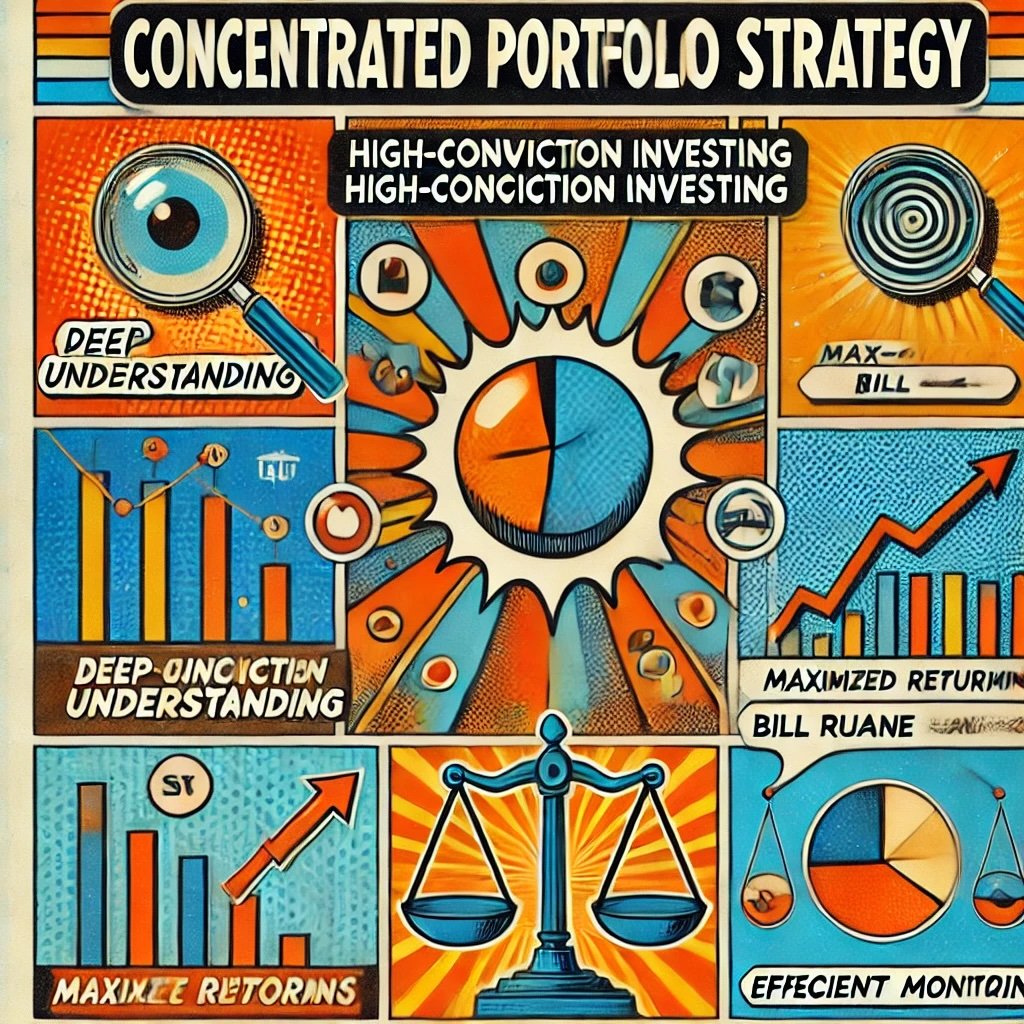
Concentrated Portfolio Strategy
High-Conviction Investing: Fewer Stocks, Greater Focus
In the world of investing, the mantra often heard is “diversify, diversify, diversify.” But Bill Ruane had a different take. He championed high-conviction investing, preferring a concentrated portfolio composed of a select number of stocks in which he had the utmost confidence. Ruane believed that if you thoroughly understand a company’s business and its long-term prospects, there’s no need to spread your investments thinly across countless stocks.
Why Concentrate?
- Deep Understanding: Focusing on fewer companies allows for more in-depth research and better insight into each investment.
- Maximized Returns: Significant investments in high-conviction stocks can lead to substantial gains if those companies perform well.
- Efficient Monitoring: Keeping track of a smaller number of holdings makes it easier to stay informed about each company’s developments.
Tip for Best Practices: When considering a concentrated portfolio, ensure you have conducted comprehensive research and are confident in each company’s long-term potential.
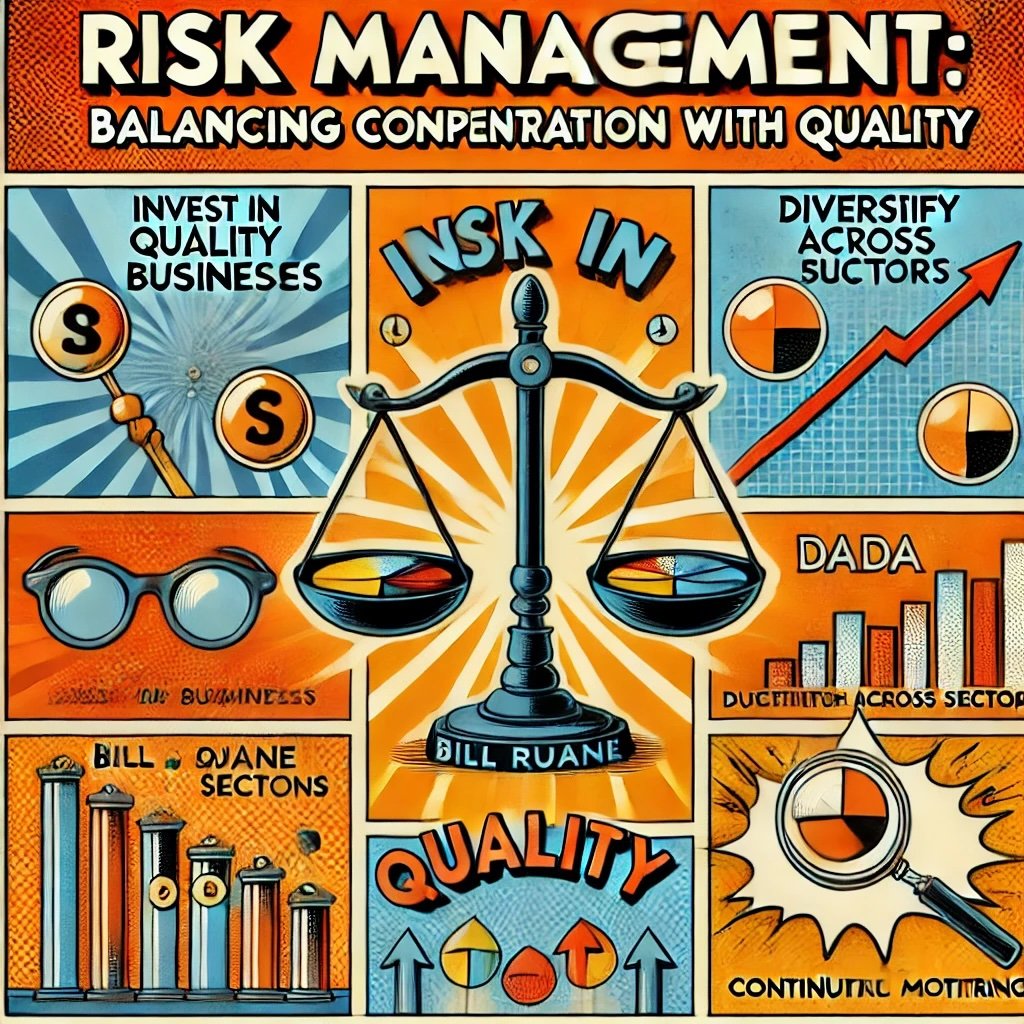
Risk Management: Balancing Concentration with Quality
While a concentrated portfolio can amplify gains, it also comes with increased risk. Ruane managed this by investing in low-risk, high-quality companies with strong fundamentals and competitive advantages. His meticulous approach to stock selection aimed to mitigate potential downsides associated with having fewer holdings.
Strategies for Risk Mitigation:
- Invest in Quality Businesses: Companies with solid financials, consistent earnings, and strong management teams are less likely to experience drastic downturns.
- Diversify Across Sectors: Even within a concentrated portfolio, Ruane diversified across different industries to avoid sector-specific risks.
- Continuous Monitoring: Regularly reviewing each investment to ensure it still meets the high standards set for inclusion in the portfolio.
Bold Move: Concentration doesn’t mean recklessness. It’s about placing well-researched bets on companies you believe in, while actively managing the associated risks.
Case Study: The Sequoia Fund’s Portfolio Composition
During Ruane’s tenure, the Sequoia Fund exemplified his concentrated portfolio strategy. Let’s take a closer look at how this approach was implemented and its impact on the fund’s performance.
Heavy Investment in Berkshire Hathaway:
One of the most notable examples of Ruane’s high-conviction investing was the Sequoia Fund’s significant stake in Berkshire Hathaway.
- Significant Allocation: At times, Berkshire Hathaway comprised a substantial portion of the fund’s total assets.
- Rationale: Ruane had immense confidence in Warren Buffett’s leadership and Berkshire’s diversified portfolio of high-quality businesses.
- Outcome: This investment paid off handsomely as Berkshire Hathaway’s value grew exponentially over the years, contributing significantly to the Sequoia Fund’s stellar returns.
Other Key Holdings:
While Berkshire Hathaway was a cornerstone, the fund also invested in other high-quality companies:
- IDEXX Laboratories: A leader in veterinary diagnostics and water testing solutions. Ruane saw long-term growth potential due to the increasing focus on pet healthcare.
- Fastenal Company: An industrial supplies distributor with a strong competitive position and consistent growth, appealing to Ruane’s preference for stable, well-managed companies.
Portfolio Characteristics:
- Limited Number of Holdings: Typically, the fund held around 25 to 30 stocks, much fewer than the average mutual fund.
- Low Turnover Rate: Ruane believed in holding investments for the long term, resulting in minimal portfolio turnover.
- Sector Diversification: Despite concentration, the fund invested across various sectors, including healthcare, industrials, consumer goods, and financials.
Lessons from the Sequoia Fund:
- Conviction Matters: Significant investments in thoroughly researched companies can lead to substantial returns.
- Quality Over Quantity: A smaller number of well-chosen investments can outperform a broad, less-focused portfolio.
- Active Risk Management: Continuous evaluation of holdings ensures they continue to meet investment criteria.
Tip for Best Practices: If considering a concentrated portfolio, diversify across industries and monitor your investments closely to manage risk effectively.
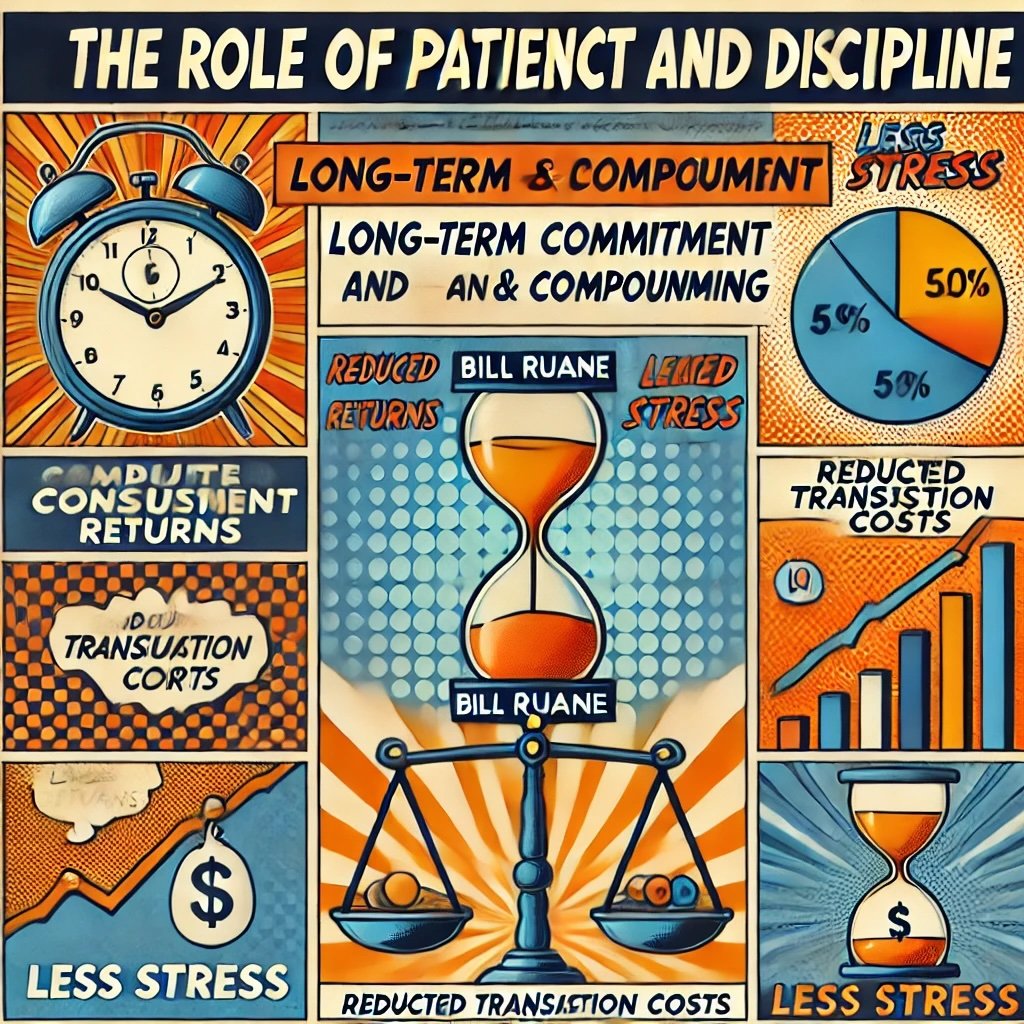
The Role of Patience and Discipline
Long-Term Commitment: Letting Compounding Work Its Magic
In the fast-paced world of investing, where headlines scream about the latest stock surges and crashes, Bill Ruane stood firm in his belief in the power of long-term commitment. He understood that true wealth isn’t built overnight but accumulates over time through the steady, almost magical process of compounding. By holding investments for the long term, Ruane allowed his portfolio to grow exponentially, reaping the benefits of compounded returns.
Why Focus on the Long Term?
- Compounding Returns: Reinvested earnings generate additional earnings, creating a snowball effect over time.
- Reduced Transaction Costs: Fewer trades mean lower fees and taxes, which can erode investment gains.
- Less Stress: Long-term investing reduces the pressure of constantly monitoring the market for short-term fluctuations.
Ruane wasn’t interested in the latest market fads or chasing quick profits. Instead, he carefully selected high-quality companies and gave them the time needed to realize their full potential. This patience often set him apart from other investors who might panic during market dips or get swept up in speculative bubbles.
Tip for Best Practices: Embrace the long game. Consider your investments as partnerships in businesses, not just ticker symbols to trade.
Avoiding Market Noise: Staying the Course Amid Fluctuations
Market volatility is inevitable. Prices rise and fall, sometimes dramatically, influenced by economic data, geopolitical events, or even investor sentiment. Ruane recognized that reacting to every market twitch was not only exhausting but counterproductive. He maintained discipline by tuning out the market noise and focusing on the underlying value of his investments.
How Did Ruane Stay Disciplined?
- Sticking to Fundamentals: He relied on thorough research and fundamental analysis rather than market speculation.
- Ignoring Short-Term Trends: Ruane didn’t let temporary market movements dictate his investment decisions.
- Maintaining Confidence: Belief in his investment choices gave him the conviction to hold steady during turbulent times.
By not getting caught up in the day-to-day market chatter, Ruane avoided making impulsive decisions that could derail his long-term strategy. His ability to remain calm and focused was a key factor in the Sequoia Fund’s sustained success.
Bold Move: Challenge yourself to resist the urge to check your portfolio every day. Trust in your research and long-term plan.
Case Study: Sequoia Fund’s Performance During Volatile Markets
Let’s take a look at how the Sequoia Fund performed during periods of market volatility by adhering to Ruane’s long-term, disciplined approach.
The 1987 Market Crash
- The Event: On October 19, 1987, known as Black Monday, stock markets around the world crashed, with the Dow Jones Industrial Average dropping over 22% in a single day.
- Sequoia Fund’s Response: Ruane didn’t panic. He viewed the downturn as an opportunity rather than a catastrophe.
- Outcome: By holding onto high-quality investments and even adding to positions at lower prices, the Sequoia Fund recovered and continued to generate strong returns in the following years.
The Dot-Com Bubble Burst (2000-2002)
- The Event: The late 1990s saw a surge in technology stock valuations, many of which were unsustainable. When the bubble burst, markets plummeted.
- Sequoia Fund’s Strategy: Ruane had largely avoided the tech frenzy, sticking to his value investing principles and focusing on companies with solid fundamentals.
- Outcome: While many funds suffered significant losses, the Sequoia Fund’s conservative, disciplined approach resulted in relatively stable performance during this tumultuous period.
Lessons from Volatile Times
- Staying True to Strategy: Ruane’s commitment to his investment philosophy provided a steady hand when others were scrambling.
- Seeing Opportunities: Market downturns were viewed as chances to invest in quality companies at discounted prices.
- Protecting Capital: By avoiding overvalued, speculative investments, the fund minimized losses during market corrections.
Tip for Best Practices: In times of market volatility, revisit your investment thesis. If the fundamentals haven’t changed, consider holding your positions or even capitalizing on lower prices.
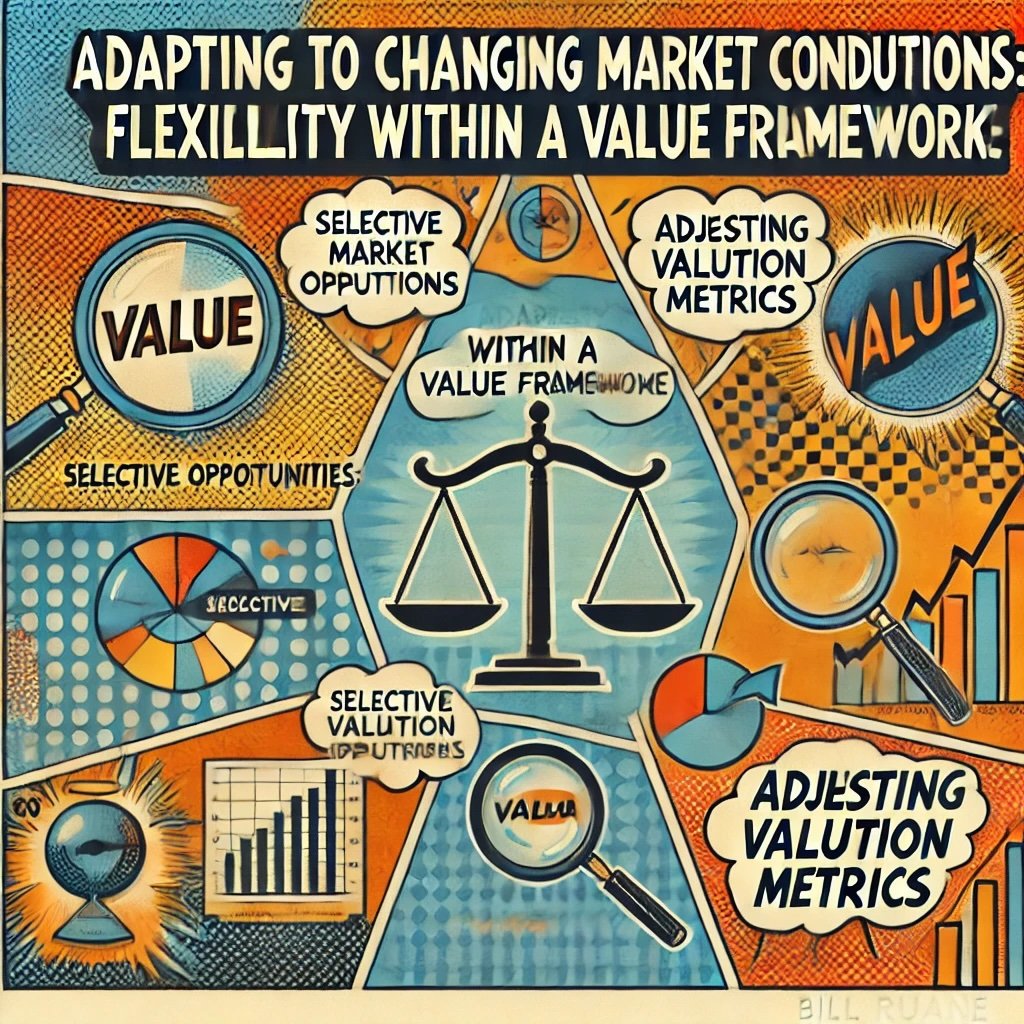
Adapting to Changing Market Conditions
Flexibility Within a Value Framework
Even the most disciplined investors know that markets are anything but static. Bill Ruane understood this better than most. While he was a staunch advocate of value investing, he also recognized the need for flexibility within his value framework to adapt to changing market environments.
So, how did Ruane manage this balancing act?
- Selective Opportunities: He remained open to investing in companies outside traditional value sectors if they met his stringent criteria.
- Evolving Industries: Ruane paid attention to emerging industries and technologies, assessing them through his value lens without dismissing them outright.
- Adjusting Valuation Metrics: He adapted his valuation methods to account for new business models while maintaining a focus on intrinsic value.
Tip for Best Practices: Stay true to your investment principles but be willing to adjust your approach as markets evolve. Flexibility doesn’t mean abandoning your strategy; it means applying it intelligently in different contexts.
Avoiding Overvaluation: Patience Over FOMO
In bull markets, it’s easy to get caught up in the hype. Stocks soar, and the fear of missing out (FOMO) can tempt even the most disciplined investors to overpay for growth. Ruane, however, held firm to the importance of not overpaying for overvalued stocks, even when the market was booming.
Why Avoid Overvaluation?
- Risk of Correction: Overpriced stocks are more vulnerable to sharp declines.
- Reduced Returns: Paying a premium today can limit future gains.
- Opportunity Cost: Capital tied up in overvalued assets can’t be used for better opportunities.
Ruane’s approach involved:
- Sticking to Valuation Principles: He relied on fundamental analysis to determine a company’s true worth.
- Resisting Market Hype: Ruane didn’t let popular trends dictate his investment choices.
- Waiting for the Right Price: Patience was key; he’d rather hold cash than invest in something overvalued.
Bold Move: It’s okay to sit on the sidelines when everything seems overpriced. Sometimes, the best action is inaction until the right opportunity comes along.
Case Study: Navigating Periods When Value Investing Was Out of Favor
During the late 1990s, the dot-com bubble was in full swing. Tech stocks were skyrocketing, and traditional value investing seemed outdated. Ruane faced significant pressure to join the frenzy, but he remained steadfast.
Ruane’s Strategy During the Dot-Com Bubble
- Avoiding the Tech Hype: Despite the allure of quick gains, he refrained from investing in overvalued tech companies without solid fundamentals.
- Focusing on Fundamentals: Ruane continued to seek companies with strong balance sheets, real earnings, and sustainable business models.
- Maintaining Discipline: He didn’t deviate from his investment criteria, even as others questioned his approach.
Outcome
- Short-Term Underperformance: The Sequoia Fund lagged behind during the tech boom, as speculative investments outpaced traditional stocks.
- Long-Term Success: When the bubble burst, many tech stocks collapsed. Ruane’s portfolio, grounded in solid fundamentals, weathered the storm and eventually outperformed.
Lessons Learned
- Stick to Your Principles: Abandoning your strategy for short-term gains can backfire.
- Value Prevails: Companies with real value tend to endure market turbulence better.
- Patience Pays Off: Staying the course can lead to superior long-term returns.
Tip for Best Practices: During market manias, reassess investments critically. Just because the crowd is moving in one direction doesn’t mean it’s the right path.
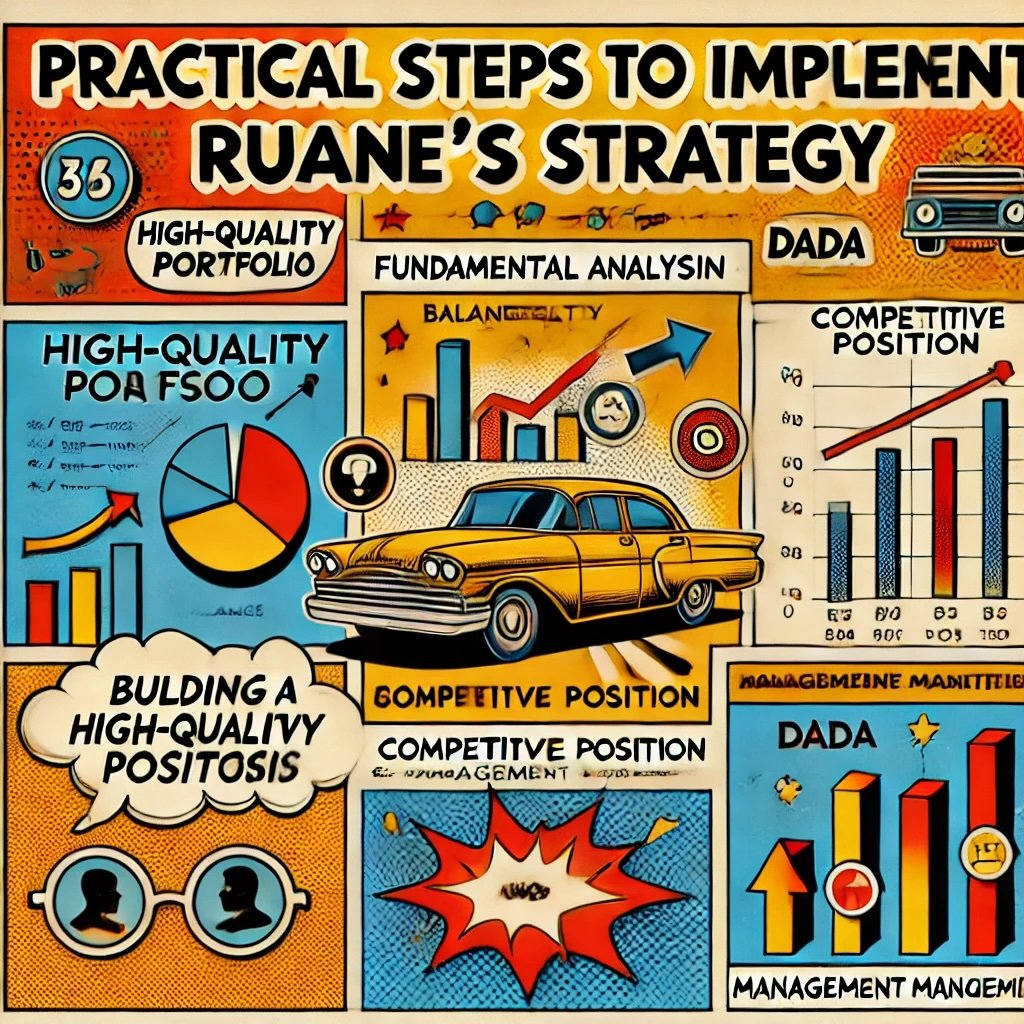
Practical Steps to Implement Ruane’s Strategy
Emulating Bill Ruane’s investment strategy begins with constructing a high-quality portfolio. This approach centers on identifying and investing in companies that exhibit strong fundamentals, robust financial health, and sustainable competitive advantages. But how do you pinpoint these standout companies amidst a vast array of options?
Building a High-Quality Portfolio
First and foremost, conduct a thorough fundamental analysis. Dive deep into a company’s financial statements—balance sheets, income statements, and cash flow statements—to assess its profitability, revenue growth, and debt levels. Look for consistent earnings and strong cash flows, which indicate a company’s ability to sustain operations and fund growth initiatives. For instance, a company with steady revenue increases, expanding profit margins, and low debt is likely managing its resources effectively and is financially stable.
Next, evaluate the competitive position of each company. Does it hold a significant market share? Does it possess unique advantages, such as proprietary technology, strong brand recognition, or cost leadership? Companies with clear competitive moats are more likely to maintain their market positions and deliver long-term value. For example, a tech company with patented technology or a consumer brand with loyal customers can fend off competitors more effectively.
Additionally, assess the quality of management. The leadership team drives the company’s vision and execution. Research the management’s track record, integrity, and strategic vision. Strong, transparent, and visionary leadership is crucial for navigating challenges and driving a company’s strategic direction. Management teams that demonstrate integrity and a history of sound decision-making are more likely to lead their companies to sustained success.
Tip for Best Practices: When researching a company, go beyond the surface. Dive into annual reports, listen to earnings calls, and read industry analyses to get a comprehensive view. This thorough approach ensures you understand not just the numbers, but the story behind them.
Concentrated vs. Diversified Portfolios
While Bill Ruane favored a concentrated portfolio, investing heavily in a select few high-conviction stocks, this approach requires careful management to mitigate associated risks. A concentrated portfolio can amplify returns but also expose you to greater potential losses if one or more investments underperform. So, how can you balance concentration with risk management?
1. Assess Your Risk Tolerance
Before adopting a concentrated approach, be honest about how much risk you’re willing to take. High-conviction investing means placing significant bets on a few stocks, which can lead to substantial gains but also notable losses if those stocks falter.
- High Conviction, High Stakes: Concentrated portfolios can outperform, but poor performance from one major holding can significantly impact your overall returns.
- Diversification for Risk Management: Spreading investments across various assets can cushion against losses in any single investment.
2. Strategies for a Concentrated Portfolio
If you opt for concentration, implement strategies that enhance the quality and resilience of your portfolio:
- Diversify Within Concentration: Even with a limited number of holdings, ensure they span different industries and sectors to avoid sector-specific downturns.
- Example: Holding stocks in healthcare, technology, and consumer goods.
- Regular Portfolio Reviews: Stay informed about your holdings’ performance and any changes in their fundamentals.
- Limit Exposure: Set clear investment limits for each position to prevent any single stock from dominating your portfolio.
Tip for Best Practices: Limit any single position to a maximum percentage of your portfolio, such as 10-15%, to prevent overexposure. This way, even if one investment doesn’t perform as expected, it won’t drastically harm your overall portfolio.
3. Blending Concentration with Diversification
To balance the benefits of a concentrated portfolio with the safety of diversification:
- Core-Satellite Approach: Combine a core of high-conviction stocks with a diversified mix of other investments. This allows you to pursue high returns while maintaining some stability.
- Use of Funds and ETFs: Incorporate mutual funds or exchange-traded funds (ETFs) to add broader market exposure without diluting your main holdings.
4. Risk Management Strategies
Effective risk management is essential when managing a concentrated portfolio:
- Set Investment Limits: Don’t invest more than a certain percentage of your portfolio in a single stock.
- Establish Stop-Loss Orders: Protect against significant losses by setting predetermined sell points.
- Hedge Your Bets: Use options or inverse ETFs to protect against downturns in key holdings.
Tip for Best Practices: Regularly reassess your portfolio to ensure it aligns with your investment goals and risk tolerance. This proactive approach helps maintain a balanced and resilient portfolio.
Staying Patient
Patience is more than a virtue in investing; it’s a strategy. Bill Ruane emphasized the importance of a long-term focus, believing that time allows investments to mature and compound, leading to superior returns. But how can you cultivate patience and maintain discipline, especially during volatile market periods?
1. Embrace a Long-Term Mindset
Start by defining your investment horizon. Understand that building wealth through high-quality investments takes time. Set clear, long-term goals and remind yourself that short-term market fluctuations are natural and often temporary. This perspective helps you stay committed to your strategy without being swayed by daily market noise.
- Compounding Returns: Allowing investments to grow over time can significantly enhance returns due to the power of compounding.
- Reduced Transaction Costs: Fewer trades mean lower fees and taxes, which can erode investment gains.
- Less Stress: Long-term investing reduces the pressure of constantly monitoring the market for short-term fluctuations.
2. Avoid Reacting to Market Noise
Market volatility is inevitable. Prices rise and fall, sometimes dramatically, influenced by economic data, geopolitical events, or investor sentiment. Ruane recognized that reacting to every market twitch was not only exhausting but counterproductive. He maintained discipline by tuning out the market noise and focusing on the underlying value of his investments.
- Stay the Course: Stick to your investment plan even when the market is turbulent.
- Trust Your Research: Confidence in your investment thesis helps you weather market storms.
- Ignore Speculation: Avoid getting caught up in the latest market rumors or hype.
3. Develop Discipline
Discipline is the backbone of a successful long-term strategy. It involves sticking to your investment principles and not letting emotions dictate your decisions.
- Set Clear Criteria: Define what makes a company a good investment and adhere to those standards.
- Regular Reviews: Periodically assess your portfolio to ensure it remains aligned with your goals.
- Stay Educated: Continuously learn about market trends and investment strategies to reinforce your confidence.
4. Use Volatility to Your Advantage
Instead of fearing market downturns, see them as opportunities to buy high-quality companies at discounted prices.
- Opportunistic Investing: Market dips can present buying opportunities for stocks you believe in.
- Dollar-Cost Averaging: Invest a fixed amount regularly, which can reduce the impact of volatility over time.
- Rebalance Your Portfolio: Adjust your holdings based on performance and changing market conditions to maintain your desired risk level.
Tip for Best Practices: Keep a journal of your investment decisions and the reasons behind them. This practice helps reinforce your commitment to a long-term strategy and provides a reference to stay disciplined during turbulent times.
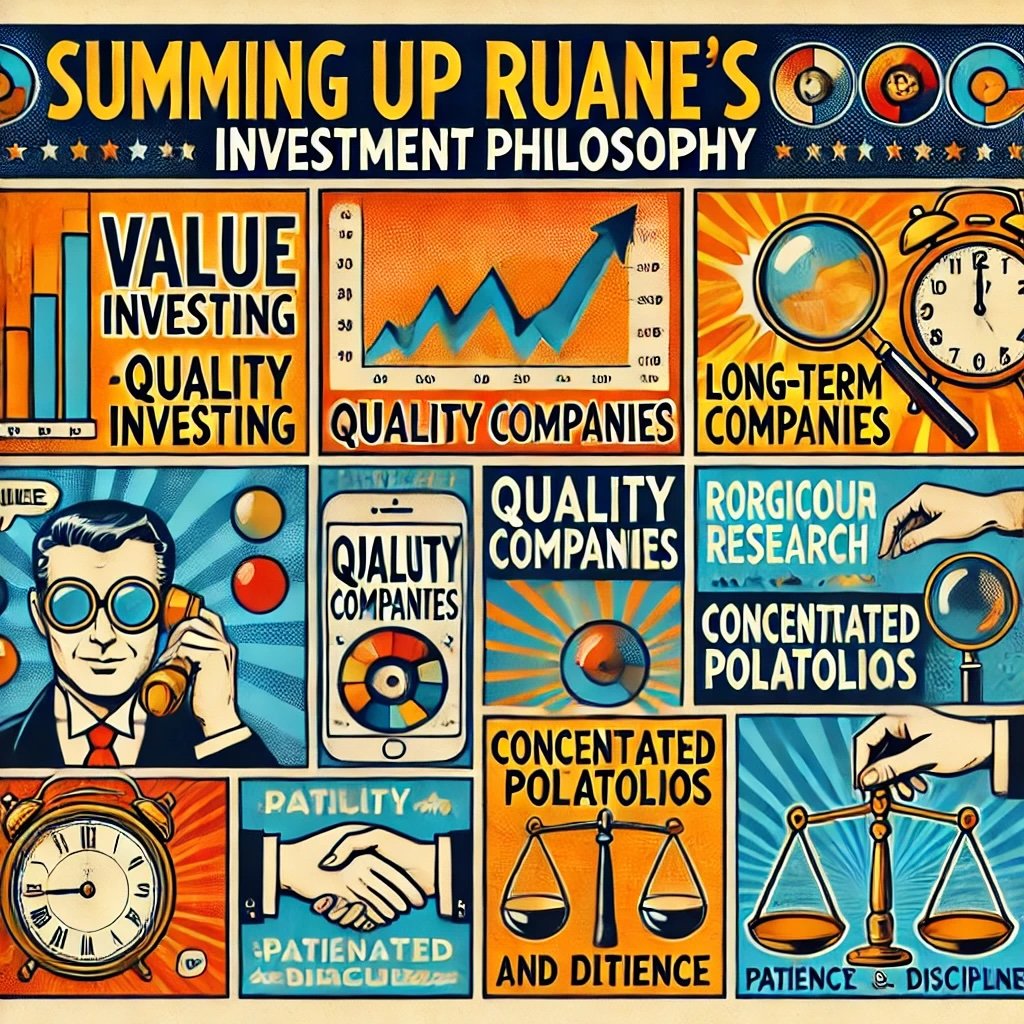
How to Invest Like Bill Ruane — Sequoia Fund Strategy Explained: 12-Question FAQ
Who was Bill Ruane and why does he matter to investors?
Bill Ruane (1925–2005) was a Graham-and-Buffett-influenced value investor who founded the Sequoia Fund (1970). His hallmark was patient, high-conviction ownership of high-quality businesses bought below intrinsic value, held for many years.
What was the core philosophy behind the Sequoia Fund?
Three pillars: value discipline (buy below intrinsic value with a margin of safety), quality bias (durable moats, superior management, strong balance sheets), and long holding periods to let compounding do the heavy lifting.
How did Ruane define “quality” in a business?
Consistent returns on capital, owner-operator or shareholder-aligned management, recurring revenue or pricing power, conservative leverage, and a business model that’s easy to understand and forecast.
What did “margin of safety” mean in practice?
Buying with a discount to conservative intrinsic value estimates (e.g., DCF with cautious assumptions, sum-of-parts with haircuts, or normalized earnings multiples) to protect against errors and downside volatility.
How concentrated was the Sequoia portfolio?
Ruane favored concentrated, high-conviction portfolios (often ~25–30 names), with position sizes reflecting conviction and risk—yet still diversified across industries to limit single-factor shocks.
How did Sequoia source ideas?
Through deep fundamental work: filings and footnotes, industry maps, channel checks, competitor comps, long management interviews, and a running watchlist of great businesses awaiting the right price.
What did the research process look like before buying?
A full underwriting memo: unit economics, moat durability, management incentives, capital allocation history, normalized earnings power, scenario analysis, and explicit sell/trim triggers if the thesis changes.
How long were holdings typically kept?
As long as the thesis stayed intact. Ruane aimed for multi-year ownership, trimming only for valuation stretch, thesis break, or superior opportunity—keeping turnover and tax drag low.
How did Ruane manage risk in a concentrated strategy?
Primarily by avoiding low-quality and leveraged models, sizing to downside scenarios, diversifying by business driver (not just sector), and maintaining a cash buffer when opportunity sets were thin.
How did he handle periods when value was out of favor?
By ignoring fashion cycles, holding cash or existing winners rather than forcing buys, and using drawdowns to upgrade quality—staying loyal to process over quarterly optics.
What can individual investors copy from Ruane today?
Adopt a quality-at-a-reasonable-price playbook: define a moat checklist, pre-commit to conservative valuation methods, cap position sizes, write thesis cards with explicit sell rules, and track process metrics (hit rate, base-rate gaps) rather than short-term returns.
What’s a simple Ruane-style starter framework?
Build a watchlist of 30–50 elite businesses;
Pre-value each with conservative assumptions;
Buy only with margin of safety;
Limit any single name to 10–15%;
Review quarterly for moat/management/valuation;
Hold while ROIC and moat persist; trim when valuation > fair value + buffer.
Summing Up Ruane’s Investment Philosophy
As we draw the curtains on our exploration of Bill Ruane’s investment philosophy and the Sequoia Fund’s approach, it’s clear that Ruane’s strategies are both timeless and highly effective. His commitment to value investing, combined with rigorous research and a steadfast long-term perspective, created a blueprint for sustained success in the investment world. Let’s recap the key takeaways from Ruane’s methodology:
- Value Investing Roots: Inspired by Benjamin Graham and influenced by his friendship with Warren Buffett, Ruane focused on identifying undervalued companies with strong fundamentals.
- Focus on Quality: He emphasized investing in high-quality companies that demonstrated robust financial health, competitive advantages, and capable management.
- Long-Term Horizon: Ruane believed in the power of patience, allowing investments to grow and compound over time without being swayed by short-term market fluctuations.
- Rigorous Research and Due Diligence: Thorough analysis of companies’ financials, competitive positioning, and management quality was central to his decision-making process.
- Concentrated Portfolio Strategy: By investing heavily in a select few high-conviction stocks, Ruane aimed to maximize returns while carefully managing associated risks.
- Patience and Discipline: Maintaining a disciplined approach and avoiding reactions to market noise were crucial for achieving long-term success.
Relevance of Ruane’s Strategies Today
In today’s dynamic and often volatile investing environment, Ruane’s strategies remain incredibly relevant. The principles he championed are not only foundational but also adaptable to modern market conditions. Here’s why his approach still matters:
- Enduring Value Investing Principles: The core tenets of value investing—buying undervalued companies with strong fundamentals—are as pertinent today as they were decades ago. In an age where market trends can shift rapidly, having a solid foundation based on intrinsic value provides stability.
- Emphasis on Quality: In a world saturated with speculative investments and high-growth startups, Ruane’s focus on quality ensures that investments are backed by tangible strengths and sustainable business models.
- Long-Term Perspective: With the rise of algorithmic trading and the emphasis on short-term gains, Ruane’s patient, long-term approach serves as a counterbalance, promoting sustainable wealth accumulation over quick profits.
- Thorough Research: In an era where information is abundant yet often superficial, Ruane’s dedication to deep, comprehensive research ensures informed and strategic investment decisions.
- Concentrated Investing with Risk Management: While diversification is a staple in many investment strategies today, Ruane’s method of concentrated investing—when paired with meticulous risk management—can lead to significant returns without unnecessary exposure.
Apply Ruane’s Principles
Adopting Bill Ruane’s investment principles doesn’t require you to have the resources of a large mutual fund. Whether you’re a seasoned investor or just starting out, these strategies can be tailored to fit your unique financial goals and risk tolerance. Here’s how you can incorporate Ruane’s wisdom into your own investment practices:
1. Adopt a Value Investing Mindset
- Focus on Fundamentals: Prioritize companies with strong financials, solid earnings growth, and manageable debt levels.
- Seek Intrinsic Value: Invest in stocks trading below their intrinsic value to build a margin of safety.
2. Prioritize Quality Over Quantity
- Select High-Quality Companies: Look for businesses with competitive advantages, excellent management, and robust market positions.
- Limit Your Holdings: Concentrate your investments in a few high-conviction stocks rather than spreading yourself too thin.
3. Commit to Long-Term Investing
- Be Patient: Allow your investments the time to grow and compound. Resist the urge to react to short-term market movements.
- Stay Disciplined: Maintain your investment strategy even during periods of market volatility.
4. Conduct Rigorous Research
- Deep Dive into Analysis: Thoroughly research potential investments, evaluating their financial health, competitive landscape, and management quality.
- Engage with Management: Whenever possible, interact with company leaders to gain deeper insights into their vision and operational strategies.
5. Implement a Concentrated Portfolio Strategy
- High-Conviction Investing: Invest heavily in a select number of stocks you believe in strongly.
- Manage Risk: Diversify within your concentrated portfolio by spreading investments across different industries and sectors to mitigate risks.
6. Maintain Patience and Discipline
- Long-Term Focus: Keep your investment horizon in mind and avoid getting swayed by daily market fluctuations.
- Emotional Control: Make decisions based on research and strategy rather than fear or greed.
Important Information
Comprehensive Investment Disclaimer:
All content provided on this website (including but not limited to portfolio ideas, fund analyses, investment strategies, commentary on market conditions, and discussions regarding leverage) is strictly for educational, informational, and illustrative purposes only. The information does not constitute financial, investment, tax, accounting, or legal advice. Opinions, strategies, and ideas presented herein represent personal perspectives, are based on independent research and publicly available information, and do not necessarily reflect the views or official positions of any third-party organizations, institutions, or affiliates.
Investing in financial markets inherently carries substantial risks, including but not limited to market volatility, economic uncertainties, geopolitical developments, and liquidity risks. You must be fully aware that there is always the potential for partial or total loss of your principal investment. Additionally, the use of leverage or leveraged financial products significantly increases risk exposure by amplifying both potential gains and potential losses, and thus is not appropriate or advisable for all investors. Using leverage may result in losing more than your initial invested capital, incurring margin calls, experiencing substantial interest costs, or suffering severe financial distress.
Past performance indicators, including historical data, backtesting results, and hypothetical scenarios, should never be viewed as guarantees or reliable predictions of future performance. Any examples provided are purely hypothetical and intended only for illustration purposes. Performance benchmarks, such as market indexes mentioned on this site, are theoretical and are not directly investable. While diligent efforts are made to provide accurate and current information, “Picture Perfect Portfolios” does not warrant, represent, or guarantee the accuracy, completeness, or timeliness of any information provided. Errors, inaccuracies, or outdated information may exist.
Users of this website are strongly encouraged to independently verify all information, conduct comprehensive research and due diligence, and engage with qualified financial, investment, tax, or legal professionals before making any investment or financial decisions. The responsibility for making informed investment decisions rests entirely with the individual. “Picture Perfect Portfolios” explicitly disclaims all liability for any direct, indirect, incidental, special, consequential, or other losses or damages incurred, financial or otherwise, arising out of reliance upon, or use of, any content or information presented on this website.
By accessing, reading, and utilizing the content on this website, you expressly acknowledge, understand, accept, and agree to abide by these terms and conditions. Please consult the full and detailed disclaimer available elsewhere on this website for further clarification and additional important disclosures. Read the complete disclaimer here.




